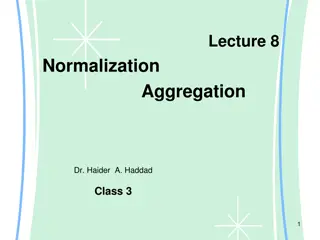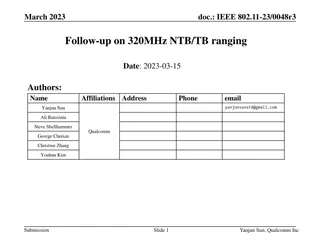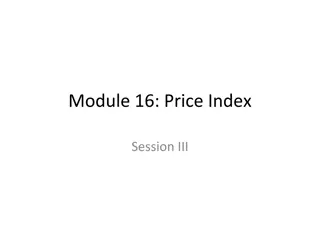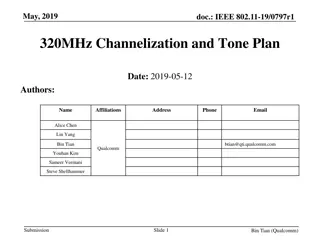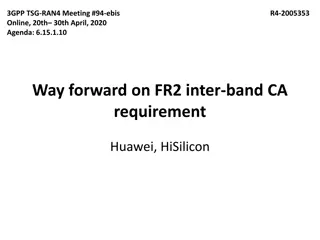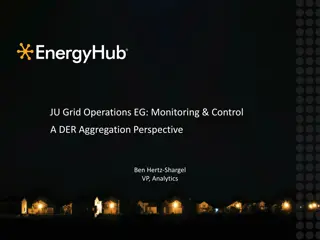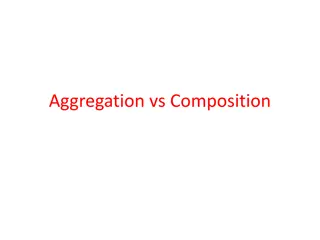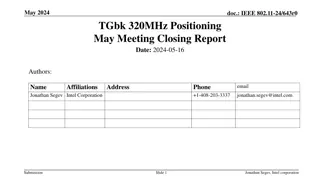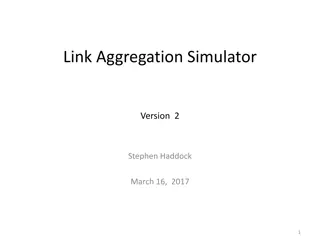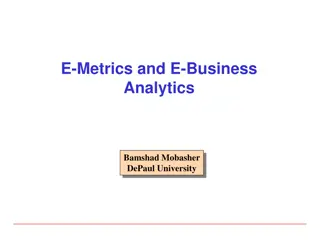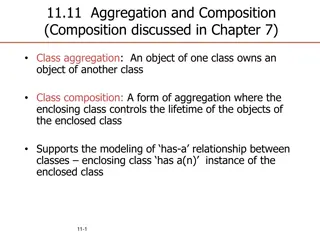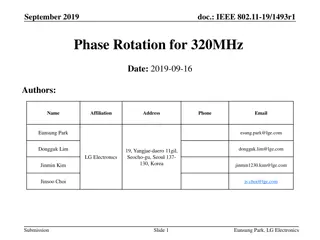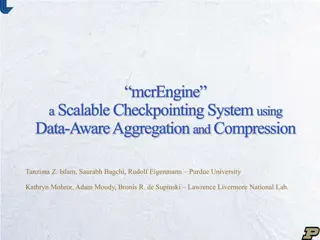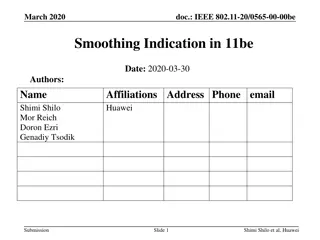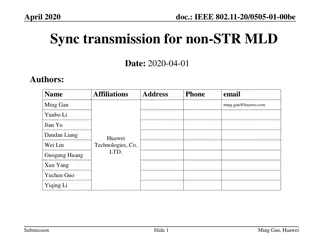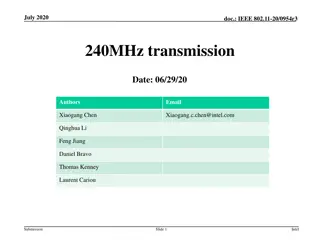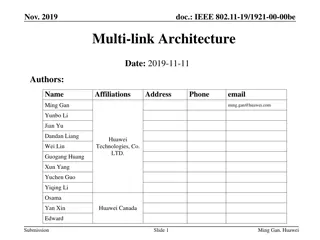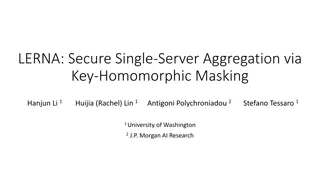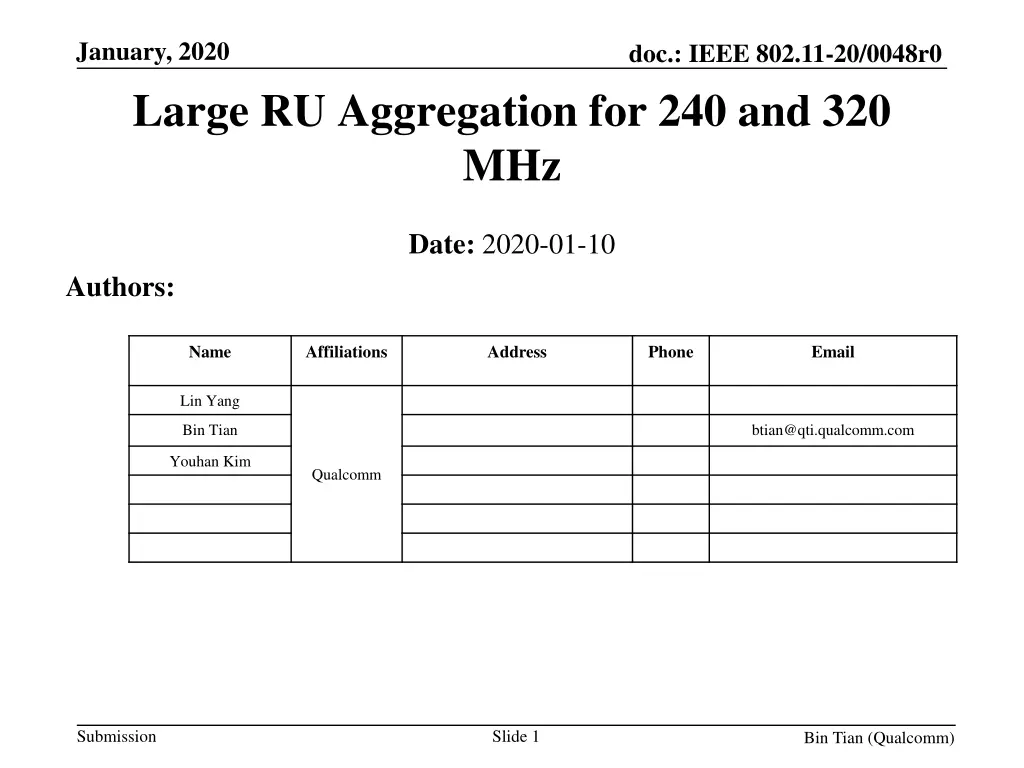
Large RU Aggregation Combinations for 240 and 320 MHz - IEEE 802.11-20/0048r0 Overview
This presentation discusses the proposed large RU aggregation combinations for 240 and 320 MHz in the IEEE 802.11-20/0048r0 document. It covers the allowed bandwidth aggregations, static puncturing scenarios, puncturing modes, and recommendations for non-OFDMA RU aggregation in the context of incumbent bandwidth distribution in the 6 GHz frequency band.
Download Presentation

Please find below an Image/Link to download the presentation.
The content on the website is provided AS IS for your information and personal use only. It may not be sold, licensed, or shared on other websites without obtaining consent from the author. If you encounter any issues during the download, it is possible that the publisher has removed the file from their server.
You are allowed to download the files provided on this website for personal or commercial use, subject to the condition that they are used lawfully. All files are the property of their respective owners.
The content on the website is provided AS IS for your information and personal use only. It may not be sold, licensed, or shared on other websites without obtaining consent from the author.
E N D
Presentation Transcript
January, 2020 Large RU Aggregation for 240 and 320 MHz doc.: IEEE 802.11-20/0048r0 Date: 2020-01-10 Authors: Name Affiliations Address Phone Email Lin Yang Bin Tian btian@qti.qualcomm.com Youhan Kim Qualcomm Submission Slide 1 Bin Tian (Qualcomm)
January, 2020 doc.: IEEE 802.11-20/0048r0 Overview For large RU (>=RU242) aggregation, the allowed combinations for up to 160MHz have been proposed[1, 2]* For non-OFDMA, 40/60MHz aggregated BW for up to 80MHz, 120/140MHz for 80~160MHz For OFDMA, 60MHz aggregated BW for up to 80MHz, 100/120MHz for 80~160MHz Large RU aggregation combinations for 240 and 320 MHz are proposed in this presentation RU in each 160MHz segment is selected from the set of existing and proposed aggregated RUs in 160 MHz case Intention is to cover typical and important puncture scenarios while limit the number of combinations to reduce implementation and testing cost *Note: for easy understanding, the aggregated RU sizes are replaced by its approximate BW in this presentation Slide 2 Submission Bin Tian (Qualcomm)
January, 2020 doc.: IEEE 802.11-20/0048r0 Typical Static Puncturing Scenarios RU combinations should be mostly optimized for static puncturing cases Distribution of incumbent bandwidth in 6 GHz [1] 30MHz incumbent happens with highest frequency 10MHz incumbent is also not negligible Submission Slide 3 Bin Tian (Qualcomm)
January, 2020 doc.: IEEE 802.11-20/0048r0 High Level Thoughts On Puncturing Modes 20 MHz_1 20 MHz_2 20 MHz_3 20 MHz_4 20 MHz_1 20 MHz_2 20 MHz_3 20 MHz_4 30MHz Incumbent 10MHz 30MHz Incumbent 10MHz One 10 MHz incumbent may affect one or two neighboring 20 MHz channels. One 30 MHz may affect two or three neighboring 20 MHz channels Focus on the RU aggregation combinations that support one puncture hole Puncture hole BW of 40 and 60 MHz need to be supported Puncture hole BW of 20MHz less important Too many combinations and less like to happen Can be covered by 40 MHz puncture hole. For wide bandwidth, loss of 20MHz is tolerable For two puncture hole in 240/320MHz, there are way too many combinations (see one example in Appendix) Needs more discussion. May want to wait for FCC s final rules on 6 GHz If to be supported, need to significantly cut down combinations and only select only a few modes Submission Slide 4 Bin Tian (Qualcomm)
January, 2020 doc.: IEEE 802.11-20/0048r0 Candidates for Non-OFDMA RU Aggregation in 320MHz Agg. BW Combinations Notes Recommendations 300 160+140 One hole of 20MHz Too many combinations, replaceable by 280 MHz Not supported Support cases with one hole of 40MHz Too many combinations with two holes. Support one hole of 40MHz case only Too many combinations with two holes. Support one hole of 60 MHz case only support Too many cases, need more discussions 280 160+120 One hole of 40 MHz 140+140 Two 20 MHz holes One 40MHz hole 260 140+120 and 160+100 Two holes: 20 and 40MHz; One hole: 60 MHz 240 160+80 120+120 Two holes: 40MHz each One hole: 80 MHz Submission Slide 5 Bin Tian (Qualcomm)
January, 2020 doc.: IEEE 802.11-20/0048r0 Candidates for Non-OFDMA RU Aggregation in 240MHz Agg. BW Combinations Notes Recommendations 220 140+80 One 20 MHz hole Too many combinations, replaceable by 200 MHz Not supported Support cases with one hole of 40MHz Too many combinations with two holes. Support one hole of 40MHz case only Too many combinations with two holes. Support one hole of 60 MHz case only Too many cases with two holes. One 80 MHz hole less likely Not supported 200 120+80 and 160+40 140+60 One 40MHz hole Two holes: 20 MHz each One hole: 40 MHz 180 120+60 and 140+40 Two Hole: 40MHz and 20Mhz One hole: 60MHz Two Hole 40 and 40Mhz One Hole 80MHz 160 120+40 and 80+80 Submission Slide 6 Bin Tian (Qualcomm)
January, 2020 Large RU Aggregation for OFDMA in 320 MHz For the OFDMA case, the supported combinations of aggregated large RUs assigned to a single STA can be further cut down Unused RUs can always be assigned to a different STA doc.: IEEE 802.11-20/0048r0 For 320MHz OFDMA, propose no aggregated RU >= 160 MHz, except for 240 MHz: RU996x3 160 MHz: RU996x2 Other case may be considered but has to be proven useful in practical system One example is 240+40 MHz ( RU 996x3 + 484) Submission Slide 7 Bin Tian (Qualcomm)
January, 2020 Large RU Aggregation for OFDMA in 240 MHz doc.: IEEE 802.11-20/0048r0 For 240 MHz OFDMA, propose no aggregated RU >= 160 MHz, except for 160 MHz: RU996x2 Other case may be considered but has to be proven useful in practical system One example is 160+40 MHz ( RU 996x2 + 484) Submission Slide 8 Bin Tian (Qualcomm)
January, 2020 doc.: IEEE 802.11-20/0048r0 Reference [1] 11-19/1908r0, Multi-RU Support [2] 11-19/1907r1, Multiple RU Combinations for EHT Submission Slide 9 Bin Tian (Qualcomm)
January, 2020 doc.: IEEE 802.11-20/0048r0 Straw Poll 1 For non-OFDMA 320MHz, do you support the following RU aggregation combinations ? Note: BW 160 is RU 996x2; BW 140 MHz is 996+(484+242); BW 120 MHz is either 996+484 or 996+(242+242); BW 100 MHz is 484+(484+242); Agg. BW Combinations Notes Recommendations 300 160+140 One hole of 20MHz Too many combinations, replaceable by 280 MHz Not supported 280 160+120 One hole of 40 MHz Support cases with one hole of 40MHz 140+140 Two 20 MHz holes One 40MHz hole Too many combinations with two holes. Support one hole of 40MHz case only 260 140+120 and 160+100 Two holes: 20 and 40MHz; One hole: 60 MHz Too many combinations with two holes. Support one hole of 60 MHz case only 240 160+80 Support 120+120 Two holes: 40MHz each One hole: 80 MHz Too many cases, TBD Yes/No/Abs Submission Slide 10 Bin Tian (Qualcomm)
January, 2020 doc.: IEEE 802.11-20/0048r0 Straw Poll 2 For non-OFDMA 240MHz, do you support the following RU aggregation BW? Note: BW 140 MHz is 996+(484+242); BW 120 MHz is either 996+484 or 996+(242+242); Agg. BW Combinations Notes Recommendations 220 140+80 One 20 MHz hole Too many combinations, replaceable by 200 MHz Not supported Support cases with one hole of 40MHz 200 120+80 and 160+40 140+60 One 40MHz hole Two holes: 20 MHz each One hole: 40 MHz Two Hole: 40MHz and 20Mhz One hole: 60MHz Two Hole 40 and 40Mhz One Hole 80MHz Too many combinations with two holes. Support one hole of 40MHz case only Too many combinations with two holes. Support one hole of 60 MHz case only 180 120+60 and 140+40 160 120+40 and 80+80 Too many cases with two holes. One 80 MHz hole less likely Not supported Yes/No/Abs Submission Slide 11 Bin Tian (Qualcomm)
January, 2020 doc.: IEEE 802.11-20/0048r0 Straw Poll 3 For OFDMA in 320MHz, do you support no aggregated RU>=160 MHz except for RU996x3 RU996x2 Note: RU996x3+484 (TBD) Yes/No/Abs Submission Slide 12 Bin Tian (Qualcomm)
January, 2020 doc.: IEEE 802.11-20/0048r0 Straw Poll 4 For OFDMA in 240 MHz, do you support no aggregated RU>=160 MHz except for RU996x2 Note: RU996x2+484 (TBD) Yes/No/Abs Submission Slide 13 Bin Tian (Qualcomm)
January, 2020 doc.: IEEE 802.11-20/0048r0 APPENDIX Submission Slide 14 Bin Tian (Qualcomm)
January, 2020 doc.: IEEE 802.11-20/0048r0 140+140 MHz Cases (Two 20 MHz holes) Many many modes (including next 3 pages) 996 996 484 484 242 242 996 484 242 996 242 484 996 996 484 242 242 484 996 242 484 996 484 242 484 996 242 996 484 242 484 996 242 484 996 242 484 996 484 996 242 242 996 996 484 242 484 242 996 996 484 484 242 242 484 996 242 484 996 242 996 996 484 242 242 484 996 242 996 484 484 242 484 996 242 996 484 242 484 996 242 484 996 242 484 996 996 484 242 242 996 996 484 242 484 242 Submission Slide 15 Bin Tian (Qualcomm)
January, 2020 doc.: IEEE 802.11-20/0048r0 140+140 MHz Cases (cont.) 996 996 484 484 242 242 242 996 484 242 996 484 484 996 996 242 242 484 24 2 24 2 24 2 242 996 242 996 484 484 484 996 242 996 484 484 996 484 996 242 484 484 996 996 242 996 996 484 242 484 242 996 996 484 484 242 242 484 996 484 996 242 242 484 996 242 996 242 484 996 242 484 996 484 242 484 996 242 996 484 242 484 996 996 242 484 242 484 996 996 484 242 242 996 996 484 484 242 242 Submission Slide 16 Bin Tian (Qualcomm)
January, 2020 doc.: IEEE 802.11-20/0048r0 140+140 MHz Cases (cont) More modes 996 996 484 484 242 242 996 484 242 996 242 484 996 996 484 242 242 484 996 242 996 484 484 242 484 996 242 996 484 242 484 996 242 484 996 242 484 996 484 996 242 242 996 996 484 242 484 242 996 996 484 484 242 242 484 996 242 484 996 242 996 996 484 242 242 484 996 242 484 996 484 242 484 996 242 484 996 242 484 996 242 484 996 242 484 996 996 484 242 242 996 996 484 242 484 242 Submission Slide 17 Bin Tian (Qualcomm)
January, 2020 doc.: IEEE 802.11-20/0048r0 140+140 MHz Cases (Cont) 996 24 2 996 484 484 242 242 996 484 242 996 484 996 484 996 242 242 484 24 2 24 2 24 2 242 996 242 484 996 484 484 996 242 996 484 484 996 484 996 242 484 484 996 996 242 996 996 484 242 484 242 996 996 484 484 242 242 996 484 996 484 242 242 484 996 242 996 242 484 996 242 996 484 484 242 484 996 242 996 484 242 484 996 996 242 484 242 484 996 996 484 242 242 996 996 484 484 242 242 Most cases are for two punctures, with each 160MHz segment punctured 20MHz. May not need to be supported One important case (highlighted in red) for one puncture of 40MHz across two 160 MHz segments Slide 18 Submission Bin Tian (Qualcomm)

